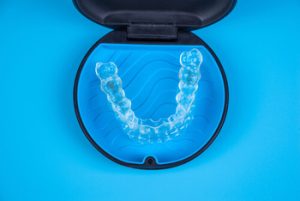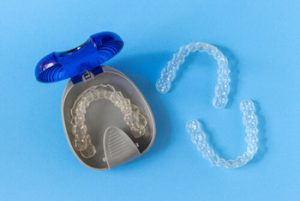When it comes to straightening teeth, the debate between Invisalign and traditional braces is a hot topic. With advancements in orthodontic treatment, individuals seeking a perfect smile now have multiple options. This comprehensive guide delves into the pros and cons of Invisalign aligners and traditional braces, including metal, ceramic, and lingual braces, to help you make an informed decision.
The Evolution of Orthodontic Treatment
The orthodontic treatment journey is fascinating and marked by significant advancements and innovations. Each development has contributed to more effective, comfortable, and aesthetically pleasing treatments, from the early use of metal bands to modern clear aligners. Let’s delve into this evolution.
Early Beginnings: The Genesis of Orthodontics
Orthodontic treatment traces its roots back to ancient times, with evidence of primitive dental braces found in mummified remains. Early dentists used materials like gold bands and catgut to correct misaligned teeth. However, these methods were rudimentary and not widely accessible.
The 20th Century: Birth of Modern Orthodontics
The real transformation in orthodontics began in the 20th century. The introduction of stainless steel in the 1960s significantly reduced the size and discomfort of metal braces, making them more popular and effective. This era also saw the development of dental adhesives, allowing brackets to be bonded directly to the teeth.
The Advent of Aesthetics: Ceramic and Lingual Braces
As demand for less noticeable braces grew, ceramic braces were introduced. Made of composite materials, they blend with the tooth’s natural colour, offering a less conspicuous option. Lingual braces, fixed behind the teeth, provided an even more invisible approach to teeth straightening.
The Invisalign Revolution
The biggest leap in orthodontic treatment came with the introduction of Invisalign in the late 1990s. These clear aligners, made of transparent, plastic material, offered a virtually invisible method to straighten crooked teeth. Custom-made for each patient, Invisalign aligners ushered in a new era of convenience and aesthetics in orthodontics.
Technology Integration: Digital Orthodontics
The integration of digital technology marked the latest phase in orthodontic evolution. 3D imaging and computer-aided design (CAD) now allow for more precise and customised treatment plans. Digital scanning technologies have replaced traditional dental impressions, enhancing patient comfort and treatment accuracy.
Looking Ahead: The Future of Orthodontics
The future of orthodontics promises even more groundbreaking advancements. Research in biomaterials and 3D printing is paving the way for even more efficient and personalised treatments. The focus continues to shift towards minimally invasive techniques, improved comfort, and faster treatment times.
Understanding Traditional Braces
Traditional braces, a mainstay in orthodontic treatment for decades, have evolved but remain a popular and effective solution for correcting many dental misalignments. Let’s explore the facets of traditional braces, including metal braces, ceramic braces, and lingual braces.
The Mechanics of Traditional Metal Braces
Metal braces, often the most recognised form of orthodontic treatment, consist of metal brackets, wires, and bands. These components apply consistent pressure on the teeth, gradually pushing them into the desired position. The versatility and effectiveness of metal braces make them suitable for treating complex orthodontic issues.
- Metal Brackets: Affixed to each tooth, these brackets act as anchors for the treatment.
- Wires: Threaded through the brackets, they exert the necessary pressure to move teeth.
- Adjustments: Regular tightening of the wires during orthodontic visits is crucial for progress.
Ceramic Braces: Aesthetic Alternatives
Ceramic braces function similarly to metal braces but offer a more aesthetic appeal and straighter teeth. The brackets are made from a ceramic material that blends with the natural colour of teeth, making them less noticeable.
- Aesthetics: Preferred by those seeking a less visible option than traditional metal braces.
- Material: While more discreet, ceramic braces can be more fragile and require careful handling.
Lingual Braces: The Invisible Option
Lingual braces represent a leap in orthodontic discretion. They are attached to the back side of the teeth, rendering them invisible from the front.
- Invisibility: Ideal for patients concerned about the appearance of braces.
- Customisation: Each bracket is custom-made to fit the unique contours of the patient’s teeth.
Orthodontic Treatment Duration and Care
Regardless of the type, traditional braces usually require a longer treatment period, ranging from 18 to 24 months, depending on the case’s complexity. They also demand diligent oral hygiene, as the brackets and wires can trap food particles.
- Regular Cleaning: Patients must be meticulous in brushing and flossing around braces.
- Dietary Adjustments: It’s advisable to avoid hard, sticky, or chewy foods that can damage the braces.
Cost Considerations
The cost of braces varies depending on the type chosen and the complexity of the treatment. Traditional metal braces are generally more affordable than their ceramic and lingual counterparts.
- Braces Cost: Metal braces are often the most cost-effective option, while ceramic and lingual braces may incur higher costs due to their materials and customisation.
The Rise of Invisalign Clear Aligners
Since its introduction, Invisalign, a name almost synonymous with clear aligners, has revolutionised the world of orthodontics. This section explores the journey, advantages, and considerations of Invisalign treatment.
The Invisalign Innovation

- Customisation: Each Invisalign tray is tailor-made using 3D imaging technology, ensuring a precise fit and effective treatment.
- Aesthetics: Invisalign aligners’ clear, nearly invisible nature makes them a favoured choice for adults and teens who are conscious about the appearance of metal braces.
Advantages of Invisalign Aligners
Invisalign aligners offer several benefits over traditional orthodontic approaches, making them popular for those seeking a discreet and convenient teeth straightening method.
- Discretion: The clear design of Invisalign aligners allows teeth straightening without brackets and wires’ noticeable presence.
- Comfort: With no sharp edges or metal parts, Invisalign trays are generally more comfortable to wear than traditional braces.
- Convenience: Invisalign trays are removable, facilitating easier eating, brushing, and flossing, thus promoting better oral hygiene.
- Customised Treatment: Advanced 3D imaging technology used in Invisalign treatments allows for a high degree of customisation, ensuring each aligner is specifically designed for the individual’s dental structure.
Treatment Process and Duration
The Invisalign treatment process involves a series of aligners, each worn for about two weeks before moving on to the next in the series. The duration of Invisalign treatments varies depending on the case’s complexity but typically ranges from 12 to 18 months.
- Regular Monitoring: Patients undergoing Invisalign treatment require regular check-ups to monitor progress and receive the next set of aligners.
- Patient Compliance: The effectiveness of Invisalign treatment is partially dependent on the patient’s adherence to wearing the aligners for the recommended 20-22 hours per day.
Considerations and Limitations
While Invisalign offers many advantages, there are certain considerations and limitations to be aware of:
- Complex Cases: Invisalign may not be suitable for certain complex orthodontic issues, where traditional braces might be more effective.
- Discipline Required: The success of Invisalign treatment heavily relies on the patient’s discipline in wearing the aligners as prescribed.
Cost and Accessibility
Invisalign treatment is often viewed as a premium orthodontic solution. The cost of Invisalign can be higher than traditional braces, reflecting the advanced technology and customisation involved.
- Investment: While the initial cost may be higher, many patients find the benefits of Invisalign aligners, such as improved aesthetics and comfort, worth the investment.
- Insurance Coverage: Some dental insurance plans offer partial coverage for Invisalign treatments, making it more accessible.
Detailed Comparison: Invisalign vs Traditional Braces
Choosing between braces vs invisalign is a significant decision for anyone considering orthodontic treatment. This detailed comparison aims to provide an in-depth understanding of both options, covering aesthetics, comfort, treatment effectiveness, duration, cost, and suitability for dental issues.
Aesthetics: The Visual Impact
Invisalign Clear Aligners
- Appearance: Invisalign aligners are almost invisible, made from clear BPA-free plastic. They are designed to be discreet, catering to the aesthetic concerns of adults and teenagers alike.
- Social Confidence: Their near invisibility offers a significant advantage in social and professional settings, where traditional dental braces might be considered intrusive.
Traditional Braces
- Visibility: Traditional metal braces are more noticeable due to their metal brackets and wires. However, they provide an opportunity for personalisation with different coloured bands.
- Ceramic Braces: As an alternative, ceramic braces offer a less noticeable solution, with brackets that blend with the natural colour of teeth.
Comfort and Convenience: Daily Experience
Invisalign Aligners
- Removability: One of the most significant advantages of Invisalign is the ability to remove the aligners for eating, brushing, and flossing, contributing to better oral hygiene and dietary freedom.
- Comfort: Without wires or brackets, Invisalign trays are generally more comfortable, reducing the risk of mouth irritation or injury.
Traditional Braces
- Fixed Nature: Being non-removable, traditional braces can be challenging when eating certain foods and maintaining oral hygiene. Patients often need to avoid hard, sticky, or chewy foods.
- Oral Sensitivity: The brackets and wires can sometimes cause discomfort, especially after adjustments.
Treatment Effectiveness: Orthodontic Capabilities
Invisalign Treatment
- Suitability: Ideal for mild to moderate alignment issues, Invisalign can effectively treat overcrowding, gaps, and some bite issues.
- Limitations: It may not be the best solution for more complex orthodontic problems, such as severe malocclusions or rotational needs.
Traditional Braces
- Versatility: Capable of addressing a broader range of orthodontic issues, including complex cases that Invisalign might not be able to treat effectively.
- Adjustment Precision: The ability to fine-tune the position of each tooth is a significant advantage of traditional braces.
Treatment Duration: Time Commitment
Invisalign Aligners
- Average Duration: Treatment typically takes 12 to 18 months, although this varies based on individual cases.
- Aligner Change: Patients transition to a new set of aligners every one to two weeks, with regular check-ups every six weeks.
Traditional Braces
- Longer Treatment: Generally, treatment with traditional braces lasts between 18 to 24 months, but it can be longer for more complex cases.
- Regular Adjustments: Orthodontic appointments for tightening and adjustments are usually scheduled every four to six weeks.
Cost: Financial Considerations
Invisalign Clear Aligners
- Pricing: Invisalign is often more expensive than traditional braces, reflecting the advanced technology and custom fabrication involved.
- Insurance and Payment Plans: Some dental insurance policies cover a portion of Invisalign treatment, and many dentists offer payment plans to manage costs.
Traditional Braces
- Affordability: Metal braces are generally more budget-friendly. The cost can vary based on the specific requirements of the treatment.
- Insurance Coverage: Most dental insurance plans that cover orthodontic treatment will include traditional braces, potentially reducing out-of-pocket expenses.
Suitability for Different Dental Conditions
Invisalign Aligners
- Best For: Effective for correcting mild to moderate dental misalignments, including some cases of overbite, underbite, crossbite, gap teeth, and crowded teeth.
- Not Ideal For Complex orthodontic issues, such as severe bite problems or significant tooth rotation, may not be suitable for Invisalign treatment.
Traditional Braces
- Broad Application: Can treat a wide array of dental issues, from simple to complex. They are particularly effective in cases where significant movement and precision are required.
- No Limitations: Traditional braces do not have the same restrictions as Invisalign and can be used in almost any orthodontic situation.
Impact on Lifestyle and Oral Hygiene
Invisalign Aligners
- Lifestyle Adaptation: Invisalign allows for a relatively normal lifestyle with few dietary restrictions. The aligners must be worn for 20-22 hours daily for optimal results.
- Oral Hygiene: Easy to maintain good oral hygiene as the aligners can be removed for thorough brushing and flossing.
Traditional Braces
- Dietary Changes: Patients must avoid certain foods that could damage the braces, like hard candies, nuts, or sticky foods.
- Hygiene Challenges: Maintaining oral hygiene can be more challenging, requiring special tools like interdental brushes for effective cleaning around the brackets and wires.
Final Decision: Personal Factors and Consultation
The choice between Invisalign and traditional braces ultimately depends on individual needs, preferences, lifestyle considerations, and dental issues. It is crucial to consult with a dental professional who can assess your unique situation and recommend the most appropriate treatment plan.
Both Invisalign and traditional braces have their unique advantages and limitations. While Invisalign offers aesthetics and convenience, traditional braces are unmatched in their versatility and effectiveness for complex cases. The decision should be made in consultation with a professional, considering all aspects of the patient’s lifestyle, dental health, and desired outcomes.
Suitability for Different Age Groups and Lifestyles
In considering orthodontic treatments, it’s crucial to recognise that the suitability of Invisalign and traditional braces varies significantly across different age groups and lifestyles. This section delves into how these orthodontic options cater to children, teenagers, and adults’ unique needs, reflecting the diversity in lifestyle demands and dental development stages.
Children and Teenagers
- Traditional Braces: Often preferred for younger patients, especially those with complex dental issues. The non-removable nature of traditional braces is beneficial for ensuring consistent treatment in younger patients who might struggle with the responsibility of removable aligners.
- Invisalign Teen: A variant of Invisalign designed specifically for teenagers, addressing their unique dental needs while offering clear aligners’ aesthetic and comfort benefits.
Adults
- Invisalign Aligners: Highly popular among adults due to their discreet appearance and minimal impact on daily life. Ideal for professionals or individuals concerned about the visibility of traditional braces.
- Ceramic and Lingual Braces: Options like ceramic and lingual braces are also popular among adults seeking less visible orthodontic solutions.
Maintenance and Oral Hygiene
- Invisalign Trays: Require regular cleaning. Since they are removable, maintaining oral hygiene is easier, allowing for regular brushing and flossing.
- Traditional Braces: Demand more meticulous cleaning around the brackets and wires. Patients must be diligent about oral hygiene to prevent plaque buildup and tooth decay.
Final Thoughts: Making the Right Choice

- Invisalign: Offers aesthetics, comfort, and convenience but may be costlier and less suitable for complex cases.
- Traditional Braces: Highly effective for a wide range of dental issues, often more affordable, but can be more noticeable and require stringent oral hygiene practices.
It’s crucial to consult with a dentist to determine the most suitable option for your specific needs. Remember, the goal is to achieve a healthy, straight smile, and both Invisalign and traditional braces are excellent paths to that outcome.
Conclusion
In conclusion, choosing between Invisalign and traditional braces is an important decision that hinges on several factors, including individual dental needs, lifestyle preferences, and age. Both options offer unique benefits and potential drawbacks, making it essential to choose a solution that aligns best with your specific requirements. Remember, the right orthodontic treatment can have a lasting impact on your dental health and overall confidence.
If you’re contemplating orthodontic treatment and need expert advice to navigate these options, Woonona Dentists are here to help. Our experienced team is dedicated to providing personalised care and guidance to ensure you make the best decision for your smile. Don’t hesitate to reach out and discuss your orthodontic needs with us. Call Woonona Dentists today at (02) 4208 0623 for a comprehensive consultation and take the first step towards a healthier, more confident smile.
References:
https://www.nhs.uk/conditions/braces-and-orthodontics/
https://www.news-medical.net/health/What-are-Dental-Braces.aspx






